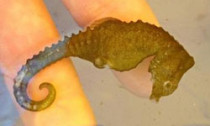
From February to April this year, I joined Dr. Tse-Lynn Loh, a postdoctoral research associate at Shedd Aquarium, as a field assistant in Vietnam – a major exporter of seahorses – to study seahorse populations here and ensure they are managed sustainably. Dr. Loh and her partners at Project Seahorse are collaborating with my institute, the Research Institute of Marine Fisheries (RIMF) in Haiphong, Vietnam, to advance seahorse conservation in Southeast Asia, a region of the world that exhibits significant marine biodiversity but is also susceptible to increased development and commercialization.
Over the past few weeks, we’ve been investigating seahorse distribution and habitat associations, as well as raising awareness about a global citizen science program that supports seahorse conservation.
This program, iSeahorse, is available as an interactive website and smartphone app that allows people to quickly log seahorse sightings whenever they encounter an animal in the wild. These data allow researchers to identify populations and places that most need conservation action.
In addition, we’re training local partners on protocols for identifying, monitoring and evaluating the reproductive status of seahorses. Our team recently led an iSeahorse monitoring workshop in Phu Quoc, the largest island in Vietnam. The workshop was hosted by the Phu Quoc Marine Park Authority (MPA), and we invited the MPA staff, as well as local fishermen and diving clubs.
The coastal waters of Phu Quoc feature tropical ecosystems, including seagrasses, coral reefs and mangroves. These ecosystems are home to diverse marine creatures, providing breeding grounds, nurseries and habitats, and seahorses are commonly found in this area.
Currently, overexploitation from shrimp nets and bottom trawling, among other factors, is leading to a decline in seahorse numbers and negatively impacting sustainable development goals. From informal interviews with fishermen and other local stakeholders, we learned that seahorses are most commonly found off Seahorse Bay at Thom Island, Ham Ninh and Da Chong Beach. In one week of diving surveys, we found 12 seahorses from three species: Hippocampus kuda , H. trimaculatus and, H. spinosissimus. Hippocampus mohnikei was only spotted from trawl boat catches, and only in small numbers. Local fishers and villagers told us that seahorses used to be much more abundant around the island.
By training these fishermen, MPA staff and other local stakeholders in iSeahorse monitoring methods, we can give them the tools they need to identify seahorse species around Phu Quoc, distinguish between male or female seahorses, describe seahorse habitats and conduct seahorse surveys. This important information helps us to protect seahorses, which in turn helps to conserve these diverse habitats for all marine life.











Social Profiles